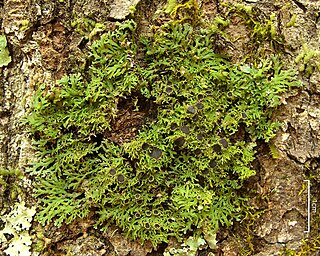
The Teloschistaceae are a large family of mostly lichen-forming fungi belonging to the class Lecanoromycetes in the division Ascomycota. Many members of the Teloschistaceae are readily identifiable by their vibrant orange to yellow hue, a result of their frequent anthraquinone content. The presence of these anthraquinone pigments, which confer protection from ultraviolet light, enabled this group to expand from shaded forest habitats to harsher environmental conditions of sunny and arid ecosystems during the Late Cretaceous. Collectively, the family has a cosmopolitan distribution, although members occur predominantly in subtropical and temperate regions. Although most members are lichens that either live on rock or on bark, about 40 species are lichenicolous fungi–meaning they live on other lichens.

The Physciaceae are a family of mostly lichen-forming fungi belonging to the class Lecanoromycetes in the division Ascomycota. A 2016 estimate placed 19 genera and 601 species in the family.

Anaptychia is a genus of lichen-forming fungi in the family Physciaceae. Anaptychia species have brown, thin-walled spores with a single septum, and a prosoplechtenchymatous upper cortex.

Heterodermia is a genus of lichenized fungi in the family Physciaceae. The genus has a widespread distribution, especially in tropical regions, and contains about 80 species.
Sedelnikovaea is a genus of placodioid lichens in the family Lecanoraceae. The genus was circumscribed in 2015 by Sergey Kondratyuk, Min-Hye Jeong, and Jae-Seoun Hur to contain Sedelnikovaea baicalensis, the type species. Three additional species were transferred into the genus in 2019.
Klaus Kalb is a German lichenologist and an authority on tropical lichens.
Dibaeis yurii is a little-known species of terricolous (ground-dwelling) lichen in the family Icmadophilaceae. It is found in the Russian Far East and in South Korea.
Gallowayella aphrodites is a species of corticolous (bark-dwelling), foliose (leafy) lichen in the family Teloschistaceae. It is found in the Mediterranean countries Greece, Cyprus, and Italy. Characteristics of the lichen include its small thallus, the disposition of the rhizines on the thallus undersurface, and the lack of vegetative propagules.
Bryostigma is a genus of lichen-forming fungi of uncertain familial placement in the order Arthoniales. The genus was circumscribed in 1979 by Josef Poelt and Peter Döbbeler, with the muscicolous lichen Bryostigma leucodontis assigned as the type species. A dozen Arthonia species were transferred into the genus in 2020 following molecular phylogenetic analysis of the family Arthoniaceae that showed distinct phylogenetic lineages that were basal to that family. The genus contains several parasitic species that occur on hosts having chlorococcoid photobionts.
Kashiwadia is a genus of lichen-forming fungi in the family Physciaceae. The genus was circumscribed in Sergey Kondratyuk, László Lőkös, and Jae-Seoun Hur in 2014 to contain the species Physcia orientalis, after molecular phylogenetic analysis showed that the taxon occupied an isolated phylogenetic position in the Physciaceae. An additional five species were added to the genus in 2021. The genus name honours Japanese lichenologist Hiroyuki Kashiwadani, who originally described the type species.
Opeltiella is a genus of lichen-forming fungi in the family Candelariaceae. The genus, established by Sergey Kondratyuk in 2020, has four species. It is differentiated from the similar genus Candelaria by its unique features such as eight-spored asci and absence of a lower cortical layer and true rhizines. The genus is characterised by its areolate to more or less squamulose or foliose thallus and the unique chemical substances it contains, such as calycin, pulvinic and vulpinic acids, and pulvinic acid lactone.

Verseghya thysanophora, commonly known as the mapledust lichen, is a species of mostly corticolous (bark-dwelling), leprose lichen in the family Pertusariaceae. This common species is widely distributed in the Northern Hemisphere. The thallus of the lichen is a thin patchy layer of granular soredia, pale green to yellowish green in colour. The main characteristics of the lichen include the presence of lichen products known as thysanophora unknowns, and the conspicuous white, fibrous prothallus that encircles the thallus.

Rusavskia is a genus of lichen-forming fungi in the family Teloschistaceae. It has 12 species. It is a member of the subfamily Xanthorioideae. The thallus of Rusavskia is characterized by its foliose (leaf-like) structure with distinct and typically narrow lobes that curve outwards.

Erichansenia is a genus of lichen-forming fungi in the family Teloschistaceae. It has three species of saxicolous (rock-dwelling), crustose lichens.

Kurokawia is a genus of lichen-forming fungi in the family Physciaceae. It has seven species of foliose lichens. The genus, circumscribed in 2021, has Kurokawia isidiata as the type species.

Kurokawia palmulata is a species of corticolous (bark-dwelling), foliose lichen in the family Physciaceae.
Hosseusiella is a genus of lichen-forming fungi in the family Teloschistaceae. It has three species of crustose to foliose (leafy) lichens, some of which grow on bark, while others grow on rock. All three occur in the southern part of the South American continent, where they are fairly common.
Orientophila is a genus of lichen-forming fungi in the family Teloschistaceae. It has 15 species of mostly saxicolous (rock-dwelling), crustose lichens. All Orientophila species occur in Northeast Asia including China, Japan, South Korea, and the Russian Far East.
Pisutiella is a genus of lichen-forming fungi in the family Teloschistaceae. It contains five species of saxicolous (rock-dwelling), crustose lichens that are found in a variety of environments in the Northern Hemisphere.
Olegblumia is a monotypic fungal genus in the family Teloschistaceae. It contains the single species Olegblumia demissa, a saxicolous (rock-dwelling) crustose lichen.







